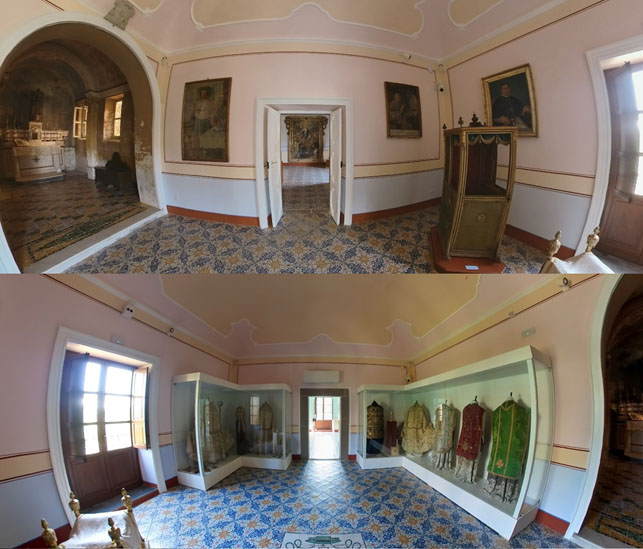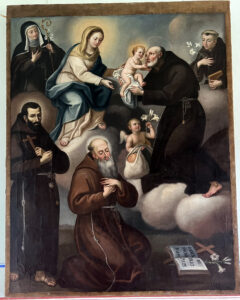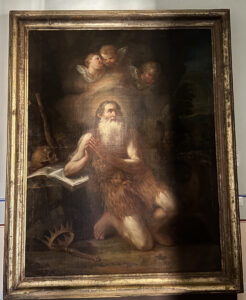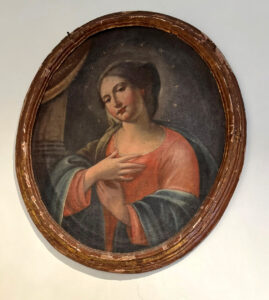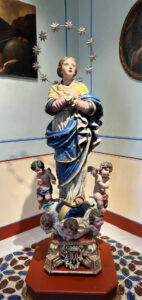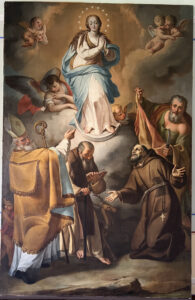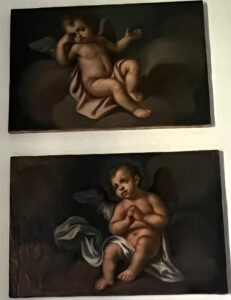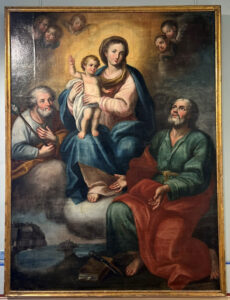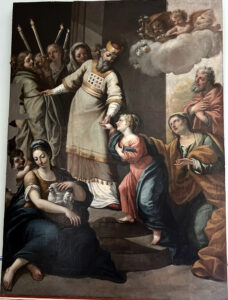Room V
Room V is dedicated to Monsignor Bonaventura Attanasio, Bishop of Lipari from 1844 to 1858. In it, one can admire, in its original location, the Sicilian majolica floor made by the bishop himself during his structural renovation of the palace, which began shortly after his arrival in Lipari.
The bishop’s coat of arms stands out, therefore, in the centre of the room, on a stone shield placed over the archway leading to the private chapel and is also reproduced on the unique bishop’s sedan chair, a work of Sicilian craftsmanship, used for travel to the Cathedral.
The two large showcases in the room display a series of vestments that belonged to some local bishops and were used during liturgical functions.
In particular, in the first showcase:
a chasuble that belonged to Monsignor Angelo Paino, Bishop of Lipari from 1909 to 1921 and later Archbishop of Messina until 1963. The precious artefact, embroidered with gold thread on gold net, comes from the church of Maria SS. Addolorata in Santa Marina Salina, the energetic prelate’s parish of origin, from which his bishop’s ring, in gold with amethyst, also comes. Another object that belonged to Bishop Paino himself is the 1934 gold chalice, given to him by the Diocese of Lipari on the 25th anniversary of his episcopate and which he bequeathed to the same Diocese;
an 18th century cope made of silk and polychrome embroidery, with elegant floral and plant embroidery, and a valuable 17th-18th century ‘Marian’ chasuble made of silk, filigree and polychrome embroidery, from the Church of the Immaculate Conception in Castello
a red chasuble belonging to Bishop Girolamo Ventimiglia, from the early 18th century, in red silk and polychrome embroidery, bearing on the back the coat of arms of the same bishop who ruled the diocese from 1694 to 1705. A famous orator, charitable and enterprising, he also dedicated himself to the restoration of the Cathedral, whose vault he had frescoed with paintings that can still be admired today;
a green chasuble that belonged to Bishop Nicolò Maria Tedeschi, made of damask silk, with exotic architectural and naturalistic motifs, which can be traced back to the ‘bizarre’ genre that became popular during the first thirty years of the 18th century due to the whimsy of its design. The back of the vestment bears the coat-of-arms of Bishop Tedeschi, Bishop of Lipari from 1710 to 1722, famous for being one of the protagonists of the Liparitan Controversy. Originating from an apparently trivial circumstance, the Controversy brought to light the problems of jurisdiction existing between the Holy See and the Royal Monarchy of Palermo, which came to openly oppose each other with serious repercussions for the ecclesiastical circumscriptions of Sicily.
In the second showcase:
a jewelled mitre that belonged to Bishop Bernardino Salvatore Re, Bishop of Lipari from 1928 to 1963, in white silk, gold embroidery and coloured stones. Embroidered on the infulae is the coat of arms of the bishop, a Capuchin of Palermo origin, who distinguished himself for his pastoral zeal and enlightened governance;
two white copes with gold embroidery, dating back to the 18th century, from the Church of Our Lady of Graces and the Church of the Immaculate Conception at Castello;
a golden mitre, with the bishop’s coat of arms on the infulas, in gold-laminated silk and sequins, from the sacristy of Lipari Cathedral.
The portraits on the walls of the room, made in oil on canvas and coming from the sacristy of Lipari Cathedral, depict several 19th-century bishops:
Monsignor Antonio Riggio, Bishop of Lipari from 1804 to 1806, signed by Carlo Minaldi, a painter active in the Messina area at the beginning of the century.
Monsignor Giovanni Portelli, Bishop of Lipari from 1831 to 1838, a native of the island.
Monsignor Ludovico Ideo, bishop of Lipari from 1858 to 1880, who established a legacy for the construction of a new cathedral, later used to build the great staircase in the early 20th century.

